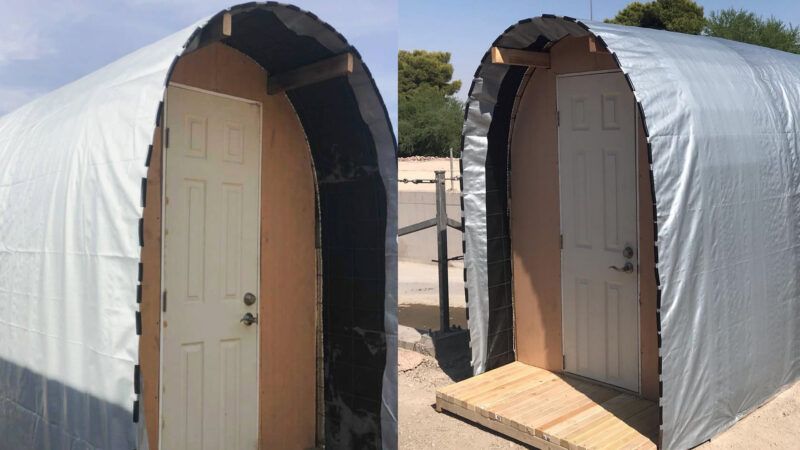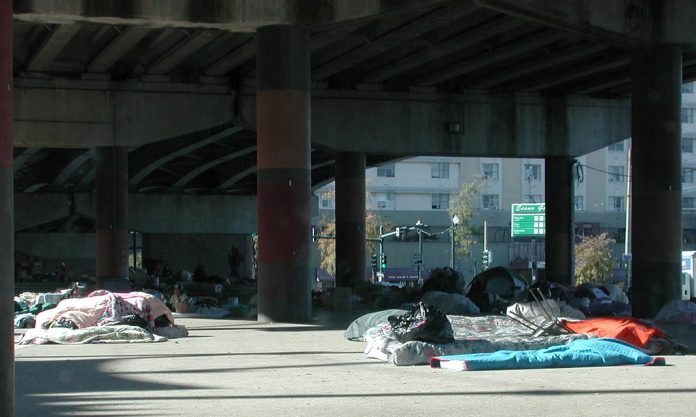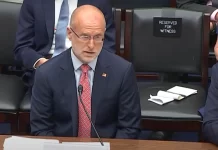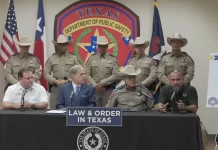Tiny Homes for Las Vegas homeless built by nonprofit on private property were demolished over code violations.
by Elizabeth Nolan Brown

Homeless shelters destroyed “to ensure the safety and welfare” of homeless people. North Las Vegas authorities demolished a community of tiny homes that sheltered the homeless because the 50-square-foot structures didn’t meet the minimum home size required by law or conform to other strict housing regulations. The situation showcases how government often thwarts private solutions to homelessness and poverty.
The tiny homes were built on private property owned by the nonprofit New Leaf Building Community. New Leaf’s structures are small and basic, featuring four walls, one window, and a front door that locks. But despite their small size and lack of amenities, they could be life-changing for people previously living on the streets.
“Now I sleep on the damn sidewalk because of this!” a man who had been living in a New Leaf home told KTNV Las Vegas. A woman named Angela said her New Leaf home made her feel “like, yes, I can do this. I can stay clean and sober. I can create. Draw. I can become anything I want to be at that moment.”
The New Leaf homes were built on private land by volunteers. The idea was to provide homeless people with “a place to call home,” said New Leaf leader Joseph Lankowski. “They had a tiny home where they could lock the door, so then they could actually go out and get services without having to worry about getting your things stolen or anything like that.”
Lankowski raised funds to buy the land after other options failed. In November 2020, the government destroyed 28 tiny homes New Leaf built on public land that had for years housed a homeless encampment. New Leaf then tried building tiny homes on trailers that could be parked in public parking spaces, but police started towing these. “And because their whole argument was property, you know, ‘This is our property. It’s not your property.’ And we said, ‘Okay. We’ll buy our own property,'” he told KNTV.
The North Las Vegas land Lankowski built on is zoned for single-family homes, which must be a minimum size of 1,200 square feet. But because there was no existing zoning for this type of project, Lankowski decided to build first and deal with bureaucracy later.
“If code enforcement’s whole premise is safety, what’s safer?” he asked. “Being in a tiny home on private property or being out on the streets?”
A bill passed by Nevada in 2021—SB 150—says large cities and counties must legalize tiny home communities by creating new building and zoning rules that pertain to them. But these rules needn’t be in place until 2024.
“Our homelessness crisis is urgent and can not wait for ‘codes’ to catch up,” New Leaf posted on Instagram in July. The post said “the city of North Las Vegas did not give us due process before bulldozing. They are not playing by their own rules. This is private property. “
The city said New Leaf housing was in violation of Uniform Housing Code and Municipal Code regulations. “Since December 2021, the City has attempted to work with the property owner to correct violations on the property,” it said in a statement to KTNV. “Rather than correct the violations, the property owner increased the pace of non-permitted construction and brought individuals to live on the property without access to fresh water, heating, cooling or adequate sewage disposal, all of which are required by SB150.”
“On multiple occasions, the City served formal notices of violations and abatement on the property and issued civil and criminal citations to the property owner,” the city added. “The owner never completed any appeals within the timeframes outlined in the various notices.”
The Nevada Department of Transportation told KTNV:
“The decision to pursue this abatement was intended to ensure the safety and welfare of both the homeless and surrounding community due to significant biohazard concerns, including bodily waste, debris and intravenous drug paraphernalia accumulating inside drainage channels that feed into the Las Vegas Wash. Other concerns included potential pedestrian-vehicle hazards from crossing the interstate, walking alongside the shoulder and/or encamping within the Union Pacific Railroad corridor, as well as obstructed driver sightlines.”
Lankowski said that New Leaf had been working to fix or appeal any violations.
“We had first aid kits. We had water. They were going to install showers,” Angela, one of the residents, told KTNV.
The situation raises questions about the ethical housing of the homeless. Some—including the city of North Las Vegas, apparently—say it’s wrong to build the homeless tiny shelters that don’t contain things like indoor plumbing, heat, or air conditioning. But is some protection from the elements better than none at all? Doesn’t having a dedicated place to sleep and store possessions matter, even if that’s all it is?
The government seems to be making the perfect the enemy of the good here.
Alas, North Las Vegas isn’t alone in seizing or destroying tiny homes built to house homeless people. City officials in Los Angeles and Denver have engaged in similar crackdowns.
Zoning rules have also been used to stop the building of homeless shelters around the country, and to prevent churches from providing beds to the homeless. Meanwhile, city attempts to build new housing for the homeless are often slow, ridiculously expensive, and inadequate.
For what it’s worth, New Leaf seems to still be building. “We can’t be stopped!” it posted to Instagram last week, in a call for volunteers to help build more tiny homes.
Originally published by Reason Foundation. Republished with permission.
For more Budget & Tax News.











“without access to fresh water, heating, cooling or adequate sewage disposal, all of which are required by SB150.”
I think Navada Gov. has a good case for those concerns, space is not a concern however for temporary shelter.
you are full of it, sleeping under an overpass doesn’t provide those services either. Government is NEVER the answer, it’s always the problem.